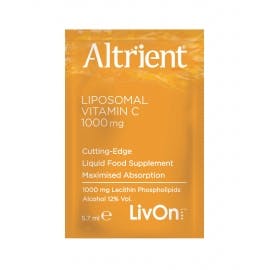Get prepped for hay fever season with Neutrient Total C
Millions of people suffer from hay fever every year but amazing new supplements like Neutrient Total C could offer new hope for sneezing sufferers.
According to the Met Office there are three main pollen seasons so if your hay fever falls on roughly the same month(s) each year then you can easily gauge which type of pollen your body is reacting to.
- Tree pollen season tends to be from late March to mid-May. Typical tree pollens which people react to include hazel, yew, alder, elm, willow, poplar, birch, ash, plane, oak, lime and pine.
- Grass pollen season tends to be from mid-May to July and all the grasses fit into the poaceae family. 95% of hay fever sufferers are allergic to grass pollen.
- Weed pollen season tends to be from the end of June to September and common weeds that trigger hay fever include dock, mugwort, nettle, oilseed rape and plantain.
The histamine connection
Histamine is stored in highly specialized mast cells that are found in the mucosal tissues of the airways. Mast cells guard against invading pathogens and when activated release large quantities of histamine to alert the body that a potentially hazardous substance is finding its way into the body. Hay fever is a standard allergic reaction that takes place when levels of pollen are detected by mast cells that line the airways.
The release of histamine attracts special immune cells into the airways, which function to destroy the pollen and flush as much of the pollen away from the body as quickly as possible. Mucus is used to wash the pollen from the eyes and nose and sneezing is initiated to expel pollen from the lungs. The histamine also triggers inflammation and swelling which functions to contain the pollen and prevent it from reaching other areas of the body. This causes redness, soreness and even headaches to occur.
Immune system support
Vitamin C has a great reputation for offering protection during the hay fever season and this is likely due to its contribution to the normal function of the immune system and its ability to protect cells from oxidative stress. It is vitamin C’s antioxidant properties that help to protect the immune cells against free radicals that are generated during an allergic inflammatory response.
Although histamine is a critical messenger molecule in times of healing, excess histamine may have a negative impact on immune balance and may aggravate conditions such as hay fever.
Itchy eyes, sore throat, streaming nose and bouts of sneezing are all signs that an inflammatory response is underway, indicating that your hay fever season may have begun – it’s histamine that triggers these allergic reactions to pollen.
However, some nutrients such as vitamin B6 and vitamin C act as enzymatic cofactors to a substance called diamine oxidase (DAO), which helps break down excess histamine, and as such may offer valuable nutritional support alongside an anti-histamine diet during your hay fever season.
Round the clock nutrition
When it comes to selecting a good vitamin C product for your hay fever toolbox make sure you choose a form of vitamin C which can be easily taken across the day. Neutrient Total C is a combination of buffered mineral ascorbates with a fat-soluble form of vitamin C called ascorbyl palmitate. These are gentle on the stomach and don’t tend to trigger the typical bowel flush associated with taking high doses of ascorbic acid (standard vitamin C).
Quercetin and bioperine
Neutrient Total C also contains other helpful nutrients such as D-ribose, DHQuercetin and a black pepper extract called bioperine. DHQuercetin is a flavonoid widely found in fruits and vegetables, which complements the actions of vitamin C and bioperine is a patented black pepper extract that may help to support absorption of vitamin C.
Six tips for an easier hay fever season
1. Use a barrier
It’s virtually impossible to filter pollen out of the air you breathe but it’s not impossible to reduce the amount of pollen entering your airways.
There are plenty of beeswax natural barrier creams that can be used within the nostrils that capture pollen entering the nose preventing it from coming into contact with your cells. Many sufferers find this a good way of reducing their symptoms.
2. Sweet honey
An age-old tradition for combating hay fever is to include locally produced honey into your diet. This helps your body build a natural defence to the pollens that you are exposed to within your local area.
3. Reduce alcohol
Wine, alcohol and beer all worsen the symptoms of hay fever and this is because all of these alcoholic drinks also contain histamine the chemical that naturally sets off the allergic reaction to pollen.
4. Omega 3 focus
According to research published in the European Journal of Clinical Nutrition a diet rich in omega-3 fats decreases the risk of hay fever. This makes it important for you to include oily fish, walnuts, flax seeds and chia seeds into your daily diet for a hay fever season omega-3 boost!
5. Chill out!
It is also worth remembering that stress may heighten the body’s sensitivity, meaning that lower levels of pollen that would normally be tolerated suddenly start to trigger symptoms. Other air pollutants such as traffic fumes can also irritate the nasal passages making it easier for hay fever to take a grip.
6. Dairy watch
Foods such as dairy products encourage the body to produce more mucus, which could enhance the severity of your allergic reaction.
Get prepared for this hay fever season so you can really start to manage your symptoms and take back control of your summer!
Susie Debice BSc Hons, Dip ION
Food Scientist and Nutritional Therapist
REFERENCES
- Yazdani Shaik BD, Conti P. Relationship between Vitamin C, Mast Cells and Inflammation. J Nutr Food Sci. 2016; 6: 456.
- Johnston C.S. (1996) The Antihistamine Action of Ascorbic Acid. In: Harris J.R. (eds) Subcellular Biochemistry. Subcellular Biochemistry (Ascorbic Acid: Biochemistry and Biochemical Cell Biology), vol 25. Springer, Boston, MA.
- https://mthfrsupport.com.au/2016/09/dao-deficiency-and-histamine-the-unlikely-connection/
- https://www.clinicaleducation.org/resources/reviews/histamine-histamine-degradation-and-histamine-intolerance/
- Janeway CA Jr, Travers P, Walport M, et al. Immunobiology: The Immune System in Health and Disease. 5th edition. New York: Garland Science; 2001. Effector mechanisms in allergic reactions.


.jpg?auto=format&q=45&w=262&trim=auto)
.jpg?auto=format&q=45&w=262&trim=auto)
